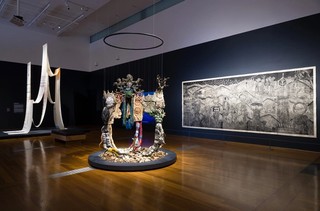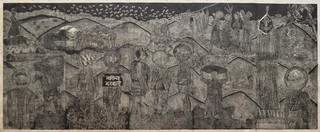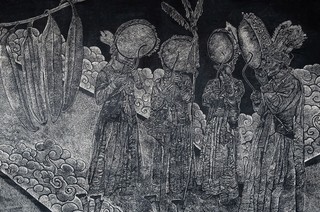Oral histories retold in breathtaking 6-metre-long woodcut print

TAMBA’s installation for the ‘The 11th Asia Pacific Triennial of Contemporary Art’ features the work of Lavkant Chaudhary, Alyen Leeachum Foning, Mekh Limbu, Keepa Maskey, Jagdish Moktan, Subas Tamang and Indu Tharu / © The artists / Photograph: C Callistemon © QAGOMA / View full image
Nepal and the surrounding region officially recognises 60 Indigenous nationalities as ‘Adivasi-Janajati’, which make up more than a third of the country’s total population. The wide range of distinct cultures, languages and histories of Nepal’s Indigenous people form the basis of the TAMBA project installed in the eleventh Asia Pacific Triennial.
Subas Tamang — one of the seven artists forming the project who’s breathtaking 6-metre-long woodcut print is on display — comes from a family of traditional stone carvers, and also has a shaman ancestor who used woodblock prints for medicinal purposes. The artist incorporates carvings, engravings, diverse printmaking techniques and oral knowledge in his art to reclaim the often erased history of the Tamang Indigenous community.

TAMBA’s installation for the ‘The 11th Asia Pacific Triennial of Contemporary Art’ features the work of Lavkant Chaudhary, Alyen Leeachum Foning, Mekh Limbu, Keepa Maskey, Jagdish Moktan, Subas Tamang and Indu Tharu / © The artists / Photograph: C Callistemon © QAGOMA / View full image

Subas Tamang, Tamang people, Nepal b.1990 / KAAITEN: History, Memory, Identity 2024 / Woodcut prints on Nepali handmade paper / Four panels: 304 × 153cm (each); 304.8 × 612cm (overall) / Purchased 2024. QAGOMA Foundation / Collection: Queensland Art Gallery | Gallery of Modern Art / © Subas Tamang / View full image
Watch | How did we install a 6-metre-long woodcut print
During the nineteenth century in Nepal, the Tamang people were subjected to extensive servitude and coercion by the state. This involved forced, unpaid work in porterage, paper manufacturing, gunpowder production and fruit farming, among other tasks. The rulers justified these atrocities by classifying the Tamangs as ‘masinya matwali’, a legally enslavable group. Consequently, this form of slavery led to the degradation of the Tamangs’ situation for generations, pushing many families into extreme poverty.
Subas’s woodcut print KAAITEN: History, Memory, Identity 2024 with images of Tamang culture serves as a poignant reminder of those painful historical events. In the Tamang community, oral histories concerning creation, cosmology and genealogy are narrated in songs sung by the Tambas — experts in ritual and the oral retelling of traditional history. These tales are often recounted in important ceremonies, with each sacred retelling accompanied by the rhythms of the Damphu percussion instrument referenced in the artwork.

Subas Tamang, Tamang people, Nepal b.1990 / KAAITEN: History, Memory, Identity (detail) 2024 / Woodcut prints on Nepali handmade paper / Four panels: 304 × 153cm (each); 304.8 × 612cm (overall) / Purchased 2024. QAGOMA Foundation / Collection: Queensland Art Gallery | Gallery of Modern Art / © Subas Tamang / View full image
Edited extract from the publication The 11th Asia Pacific Triennial of Contemporary Art, QAGOMA, 2024
Asia Pacific Triennial
30 November 2024 – 27 April 2025
Queensland Art Gallery and Gallery of Modern Art (QAGOMA)
Brisbane, Australia
Free entry

